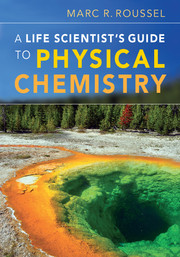Book contents
- Frontmatter
- Contents
- Preface
- 1 Orientation: what is physical chemistry about?
- Part One Quantum mechanics and spectroscopy
- Part Two Thermodynamics
- 4 Thermodynamics preliminaries
- 5 The First Law of Thermodynamics
- 6 The Second Law of Thermodynamics
- 7 Free energy
- 8 Chemical equilibrium and coupled reactions
- 9 Non-ideal behavior
- 10 Electrochemistry
- Part Three Kinetics
- Appendix A Standard thermodynamic properties at 298.15 K and 1 bar
- Appendix B Standard reduction potentials at 298.15 K and 1 bar
- Appendix C Physical properties of water
- Appendix D The SI system of units
- Appendix E Universal constants and conversion factors
- Appendix F Periodic table of the elements, with molar masses
- Appendix G Selected isotopic masses and abundances
- Appendix H Properties of exponentials and logarithmic functions
- Appendix I Review of integral calculus
- Appendix J End-of-term review problems
- Appendix K Answers to exercises
- Index
10 - Electrochemistry
from Part Two - Thermodynamics
Published online by Cambridge University Press: 05 June 2012
- Frontmatter
- Contents
- Preface
- 1 Orientation: what is physical chemistry about?
- Part One Quantum mechanics and spectroscopy
- Part Two Thermodynamics
- 4 Thermodynamics preliminaries
- 5 The First Law of Thermodynamics
- 6 The Second Law of Thermodynamics
- 7 Free energy
- 8 Chemical equilibrium and coupled reactions
- 9 Non-ideal behavior
- 10 Electrochemistry
- Part Three Kinetics
- Appendix A Standard thermodynamic properties at 298.15 K and 1 bar
- Appendix B Standard reduction potentials at 298.15 K and 1 bar
- Appendix C Physical properties of water
- Appendix D The SI system of units
- Appendix E Universal constants and conversion factors
- Appendix F Periodic table of the elements, with molar masses
- Appendix G Selected isotopic masses and abundances
- Appendix H Properties of exponentials and logarithmic functions
- Appendix I Review of integral calculus
- Appendix J End-of-term review problems
- Appendix K Answers to exercises
- Index
Summary
I have to admit that I wasn't fond of electrochemistry when I was a student. It has since grown on me. Looking back, I think that I was told too much in my first exposure to the subject. Electrochemistry is a fussy science, with all kinds of complications that can make it difficult to obtain reproducible data from experiments. If your professors tell you about all these complications up front, then it becomes difficult to appreciate the utility of the subject. You just lose track of the big picture in a haze of contact potentials and transference numbers. That being said, it's possible to go too far the other way and to leave out important details you ought to know about when studying electrochemistry. I'm going to try to steer a middle course, one that emphasizes that electrochemistry is one of the key ways to get thermodynamic data, but also one that points out some of the things you need to think about when you do electrochemistry. Hopefully, you'll come through this experience with more enthusiasm for electrochemistry than I had when I was in your place.
Free energy and electromotive force
In several of the problems in Chapter 7, we used the fact that the maximum electrical work can be calculated from the Gibbs free energy, the latter representing the maximum (reversible) non-pV work. Electrochemical cells convert chemical into electrical energy, or vice versa.
- Type
- Chapter
- Information
- A Life Scientist's Guide to Physical Chemistry , pp. 202 - 220Publisher: Cambridge University PressPrint publication year: 2012



